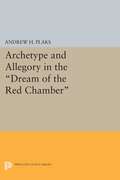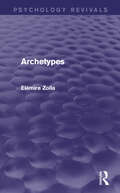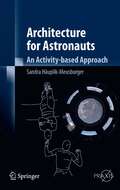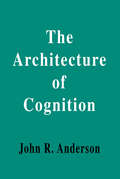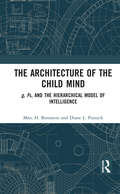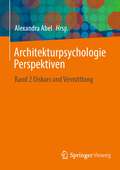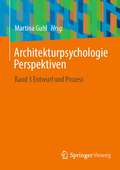- Table View
- List View
Archetype and Allegory in the "Dream of the Red Chamber" (PDF)
by Andrew H. PlaksSurprisingly little has been written in Western languages about the eighteenth- century Chinese novel Dream of the Red Chamber, perhaps the supreme masterpiece of its entire tradition. In this study, Andrew H. Plaks has used the conceptual tools of comparative literature to focus on the novel's allegorical elements and narrative structure. He thereby succeeds in accounting for the work's greatness in terms that do justice to its own narrative tradition and as well to recent advances in general literary theory.A close textual reading of the novel leads to discussion of a wide range of topics: ancient Chinese mythology, Chinese garden aesthetics, and the logic of alternation and recurrence. The detailed study of European allegorical texts clarifies the directions taken by comparable works of Chinese literature, and the critical tool of the literary archetype helps to locate the novel within the Chinese narrative tradition from ancient mythology to the more recent "novel" form. Professor Plaks' innovative use of traditional criticism suggests the levels of meaning the eighteenth-century author might have expected to convey to his immediate audience.This book provides not only an illuminating analysis of this important novel, but also a significant demonstration that critical concepts derived primarily from Western literary models may be fruitfully applied to Chinese narrative works.Originally published in 1976.The Princeton Legacy Library uses the latest print-on-demand technology to again make available previously out-of-print books from the distinguished backlist of Princeton University Press. These editions preserve the original texts of these important books while presenting them in durable paperback and hardcover editions. The goal of the Princeton Legacy Library is to vastly increase access to the rich scholarly heritage found in the thousands of books published by Princeton University Press since its founding in 1905.
Archetype and Character: Power, Eros, Spirit, and Matter Personality Types
by V. OdajnykIntroducing a new typology based on Power, Eros, Matter and Spirit as the motivations that define human attitudes and behaviour, the book outlines eight personality types based on the extraverted and introverted deployment of the four drives and applies these typological categories to Freud, Adler and Jung.
Archetype, Attachment, Analysis: Jungian Psychology and the Emergent Mind
by Jean KnoxArchetype, Attachment, Analysis is a well-researched presentation of new material that offers a revision and reinterpretation of Jung's archetypal hypothesis. The author's ground breaking new exploration of expanding knowledge from other disciplines such as cognitive science and developmental psychology, and attachment theory and research evidence sheds important new light on Jungian theory and practice. Using information gathered through laboratory investigations and natural observational studies Jean Knox brings the notion of archetypes up to date and considers the implications of new paradigms for clinical work with patients. This book will become essential reading for all professionals and students of analytical psychology.
Archetype, Attachment, Analysis: Jungian Psychology and the Emergent Mind
by Jean KnoxArchetype, Attachment, Analysis is a well-researched presentation of new material that offers a revision and reinterpretation of Jung's archetypal hypothesis. The author's ground breaking new exploration of expanding knowledge from other disciplines such as cognitive science and developmental psychology, and attachment theory and research evidence sheds important new light on Jungian theory and practice. Using information gathered through laboratory investigations and natural observational studies Jean Knox brings the notion of archetypes up to date and considers the implications of new paradigms for clinical work with patients. This book will become essential reading for all professionals and students of analytical psychology.
Archetype, Culture, and the Individual in Education: The Three Pedagogical Narratives
by Clifford MayesIn Archetype, Culture, and the Individual in Education: The Three Pedagogical Narratives, Clifford Mayes presents a unique approach to understanding how Jungian principles can inform pedagogical theory and practice. In a time when what the educational historian Lawrence Cremin called the 'military-industrial-educational complex' and its standardized education are running roughshod over the psyche and spirit of students, Mayes deploys depth psychology, especially the work of Jung, to advance an archetypal approach to teaching and learning. Mayes demonstrates how catastrophic it is to students when the classroom is governed by forces that objectify the individual in a paralysing stranglehold. He argues that one’s life-narrative is significantly impacted by one’s narrative as a learner; thus, schooling that commodifies learning and turns the student into an object has neuroticizing effects that will spread throughout that student’s entire life. In Part I, Mayes explores the interaction between archetypes and various types of time—ultimately focusing on the individual but always mediated by ‘the cultural unconscious’. In Parts II and III, he brings together education with (post-)Jungian and (post-)Freudian psychology, examining transference/countertransference in the classroom; the Jungian idea of ‘the shadow’ applied to educational processes; Jung’s unique vision of ‘the symbol’ and its importance for educational theory; and Jung’s ‘transcendent function’ as a prime educational modality. Mayes concludes by looking to the future of archetypal pedagogy. This groundbreaking work in the emerging field of Jungian pedagogy is invaluable reading in Jungian Studies, depth psychological theory, educational theory, and for teachers and psychotherapists.
Archetype, Culture, and the Individual in Education: The Three Pedagogical Narratives
by Clifford MayesIn Archetype, Culture, and the Individual in Education: The Three Pedagogical Narratives, Clifford Mayes presents a unique approach to understanding how Jungian principles can inform pedagogical theory and practice. In a time when what the educational historian Lawrence Cremin called the 'military-industrial-educational complex' and its standardized education are running roughshod over the psyche and spirit of students, Mayes deploys depth psychology, especially the work of Jung, to advance an archetypal approach to teaching and learning. Mayes demonstrates how catastrophic it is to students when the classroom is governed by forces that objectify the individual in a paralysing stranglehold. He argues that one’s life-narrative is significantly impacted by one’s narrative as a learner; thus, schooling that commodifies learning and turns the student into an object has neuroticizing effects that will spread throughout that student’s entire life. In Part I, Mayes explores the interaction between archetypes and various types of time—ultimately focusing on the individual but always mediated by ‘the cultural unconscious’. In Parts II and III, he brings together education with (post-)Jungian and (post-)Freudian psychology, examining transference/countertransference in the classroom; the Jungian idea of ‘the shadow’ applied to educational processes; Jung’s unique vision of ‘the symbol’ and its importance for educational theory; and Jung’s ‘transcendent function’ as a prime educational modality. Mayes concludes by looking to the future of archetypal pedagogy. This groundbreaking work in the emerging field of Jungian pedagogy is invaluable reading in Jungian Studies, depth psychological theory, educational theory, and for teachers and psychotherapists.
Archetype Revisited: An Updated Natural History of the Self (Routledge Mental Health Classic Editions)
by Anthony StevensArchetype: A Natural History of the Self, first published in 1982, was a ground-breaking book; the first to explore the connections between Jung's archetypes and evolutionary disciplines such as ethology and sociobiology, and an excellent introduction to the archetypes in theory and practical application as well. C.G. Jung's 'archetypes of the collective unconscious' have traditionally remained the property of analytical psychology, and have commonly been dismissed as 'mystical' by scientists. But Jung himself described them as biological entities, which, if they exist at all, must be amenable to empirical study. In the work of Bowlby and Lorenz, and in studies of the bilateral brain, Anthony Stevens has discovered the key to opening up this long-ignored scientific approach to the archetypes, originally envisaged by Jung. At last, in a creative leap made possible by the cross-fertilisation of several specialist disciplines, psychiatry can be integrated with psychology, with ethology and biology. The result is an immensely enriched science of human behaviour. In Archetype Revisited, Stevens considers the enormous cultural, social and intellectual changes that have taken place since the publication of the original edition, and includes: - An updated chapter on The Archetypal Masculine and Feminine, reflecting recent research findings and developments in feminist thinking; - Commentary on the intrusion of neo-Darwinian thinking into psychology and psychiatry; - Analysis of what has happened to the archetype in terms of our understanding of it and our responses to it. This Classic Edition of the book includes a new introduction by the author.
Archetype Revisited: An Updated Natural History of the Self (Routledge Mental Health Classic Editions #Vol. 105)
by Anthony StevensArchetype: A Natural History of the Self, first published in 1982, was a ground-breaking book; the first to explore the connections between Jung's archetypes and evolutionary disciplines such as ethology and sociobiology, and an excellent introduction to the archetypes in theory and practical application as well. C.G. Jung's 'archetypes of the collective unconscious' have traditionally remained the property of analytical psychology, and have commonly been dismissed as 'mystical' by scientists. But Jung himself described them as biological entities, which, if they exist at all, must be amenable to empirical study. In the work of Bowlby and Lorenz, and in studies of the bilateral brain, Anthony Stevens has discovered the key to opening up this long-ignored scientific approach to the archetypes, originally envisaged by Jung. At last, in a creative leap made possible by the cross-fertilisation of several specialist disciplines, psychiatry can be integrated with psychology, with ethology and biology. The result is an immensely enriched science of human behaviour. In Archetype Revisited, Stevens considers the enormous cultural, social and intellectual changes that have taken place since the publication of the original edition, and includes: - An updated chapter on The Archetypal Masculine and Feminine, reflecting recent research findings and developments in feminist thinking; - Commentary on the intrusion of neo-Darwinian thinking into psychology and psychiatry; - Analysis of what has happened to the archetype in terms of our understanding of it and our responses to it. This Classic Edition of the book includes a new introduction by the author.
Archetypes (Psychology Revivals)
by Elémire ZollaMan is dominated by his archetypes; they mould not only his history but his dreams. But how are we to define and evaluate them? Is it perhaps possible for us to relate more creatively to them? Originally published in 1981, these are some of the questions raised by this title. To answer them the author gathered together a vast amount of material drawn from Eastern and Western traditions, from science, literature, art and poetry. The answers he puts forward are often highly original and will surely challenge many of our most cherished patterns of thought. There emerges from this book what can only be described as a global metaphysical system, yet the author’s language is not that of an ordinary metaphysical treatise, and what he writes offered new challenge and hope to those suffering from the despair and cynicism engendered by a great deal in modern society at the time. Zolla does not, however, advocate a return to earlier historical patterns, nor is he proposing a new Utopia, but rather offers us a brilliant series of lessons in the art of centring. In the words of Bernard Wall, writing in the Times Literary Supplement, Zolla’s ‘deep, polymathic probing of the terms of human existence makes it sensible to compare him with Simone Weil, while some of his conclusions about ultimate mysteries – expressed in signs, symbols and sacraments, the sense of which we have lost – will make us think of the later T. S. Eliot’.
Archetypes (Psychology Revivals)
by Elémire ZollaMan is dominated by his archetypes; they mould not only his history but his dreams. But how are we to define and evaluate them? Is it perhaps possible for us to relate more creatively to them? Originally published in 1981, these are some of the questions raised by this title. To answer them the author gathered together a vast amount of material drawn from Eastern and Western traditions, from science, literature, art and poetry. The answers he puts forward are often highly original and will surely challenge many of our most cherished patterns of thought. There emerges from this book what can only be described as a global metaphysical system, yet the author’s language is not that of an ordinary metaphysical treatise, and what he writes offered new challenge and hope to those suffering from the despair and cynicism engendered by a great deal in modern society at the time. Zolla does not, however, advocate a return to earlier historical patterns, nor is he proposing a new Utopia, but rather offers us a brilliant series of lessons in the art of centring. In the words of Bernard Wall, writing in the Times Literary Supplement, Zolla’s ‘deep, polymathic probing of the terms of human existence makes it sensible to compare him with Simone Weil, while some of his conclusions about ultimate mysteries – expressed in signs, symbols and sacraments, the sense of which we have lost – will make us think of the later T. S. Eliot’.
Archetypical Roles in Startups: Eight Personality Traits You Need in Your Founding Team (Business Guides on the Go)
by Vanessa Miller Jens U. PätzmannFounding a startup is a challenging endeavor that works best in a well-balanced team. Different thinking styles are needed throughout the founding journey. Archetypes are deeply engrained templates in the collective unconscious and can be used to reveal the hidden aspects of social interactions within teams. This book employs an archetypical personality test to uncover the eight most significant team roles needed in a startup: the leader, the mentor, the artist, the friend, the hero, the femme fatale, the rebel and the manager. The artist, for example, always finds unconventional solutions, the femme fatale attracts support for the idea, and the hero is undaunted in the face of setbacks. Archetypical roles can manifest in individuals or at the group level, and they can and should change throughout the journey. With the included personality test, this book offers entrepreneurs, investors and mentors alike a tool to improve the interpersonal processes in startup teams.
Archipelago of Consciousness: The Invisible Sovereignty of Life
by Mauro MaldonatoFew dilemmas in the history of human thought have aroused debates so exciting as that on consciousness. In the past, few scholars recognised scientific dignity to the issue, perhaps because of its subjective nature. Conditioned by limitations of the introspective method and by the unnatural opposition between conscious and unconscious, the study of consciousness has been the exclusive prerogative of philosophy, literature and theology, strengthening the prejudice that separates humanistic and scientific culture. Mauro Maldonato sets out to establish a fruitful dialogue between different disciplines, investigating consciousness from points of view that shape awareness of ourselves and of the world. For every one of us, consciousness is a primary, immediate, permanent fact the core of life itself. Why, then, are we so far from forming any definitive picture of what it is, and what it means for us? The study of the biological bases for consciousness has shown how physics is incapable of providing credible solutions; the lack of means to describe the interactions between neuronal structures and qualitative experiences leads to an investigative dead end. But this explanatory shortfall does not authorise us to postulate the existence of an inaccessible sancta sanctorum. A scientific project to naturalise consciousness attempting to ground our relational life and human action in biology has to recognise issues of complexity, and the irreversibility and historical contingency of our individual phenomenalistic experience. The ground-breaking Archipelago of Consciousness: How Biology invents Culture follows the author's well received writings on Natural Logic, Decision Making and the Predictive Brain.
Architecture and the Mimetic Self: A Psychoanalytic Study of How Buildings Make and Break Our Lives
by Lucy HuskinsonBuildings shape our identity and sense of self in profound ways that are not always evident to architects and town planners, or even to those who think they are intimately familiar with the buildings they inhabit. Architecture and the Mimetic Self provides a useful theoretical guide to our unconscious behaviour in relation to buildings, and explains both how and why we are drawn to specific elements and features of architectural design. It reveals how even the most uninspiring of buildings can be modified to meet our unconscious expectations and requirements of them—and, by the same token, it explores the repercussions for our wellbeing when buildings fail to do so. Criteria for effective architectural design have for a long time been grounded in utilitarian and aesthetic principles of function, efficiency, cost, and visual impact. Although these are important considerations, they often fail to meet the fundamental needs of those who inhabit and use buildings. Misconceptions are rife, not least because our responses to architecture are often difficult to measure, and are in large part unconscious. By bridging psychoanalytic thought and architectural theory, Architecture and the Mimetic Self frees the former from its preoccupations with interpersonal human relations to address the vital relationships that we establish with our nonhuman environments. In addition to providing a guide to the unconscious behaviours that are most relevant for evaluating architectural design, this book explains how our relationships with the built environment inform a more expansive and useful psychoanalytic theory of human relationship and identity. It will appeal to psychoanalysts and analytical psychologists, architects, and all who are interested in the overlaps of psychology, architecture, and the built environment.
Architecture and the Mimetic Self: A Psychoanalytic Study of How Buildings Make and Break Our Lives
by Lucy HuskinsonBuildings shape our identity and sense of self in profound ways that are not always evident to architects and town planners, or even to those who think they are intimately familiar with the buildings they inhabit. Architecture and the Mimetic Self provides a useful theoretical guide to our unconscious behaviour in relation to buildings, and explains both how and why we are drawn to specific elements and features of architectural design. It reveals how even the most uninspiring of buildings can be modified to meet our unconscious expectations and requirements of them—and, by the same token, it explores the repercussions for our wellbeing when buildings fail to do so. Criteria for effective architectural design have for a long time been grounded in utilitarian and aesthetic principles of function, efficiency, cost, and visual impact. Although these are important considerations, they often fail to meet the fundamental needs of those who inhabit and use buildings. Misconceptions are rife, not least because our responses to architecture are often difficult to measure, and are in large part unconscious. By bridging psychoanalytic thought and architectural theory, Architecture and the Mimetic Self frees the former from its preoccupations with interpersonal human relations to address the vital relationships that we establish with our nonhuman environments. In addition to providing a guide to the unconscious behaviours that are most relevant for evaluating architectural design, this book explains how our relationships with the built environment inform a more expansive and useful psychoanalytic theory of human relationship and identity. It will appeal to psychoanalysts and analytical psychologists, architects, and all who are interested in the overlaps of psychology, architecture, and the built environment.
Architecture for Astronauts: An Activity-based Approach (Springer Praxis Books)
by Sandra Häuplik-MeusburgerLiving and working in extra-terrestrial habitats means being potentially vulnerable to very harsh environmental, social, and psychological conditions. With the stringent technical specifications for launch vehicles and transport into space, a very tight framework for the creation of habitable space is set. These constraints result in a very demanding “partnership” between the habitat and the inhabitant. This book is the result of researching the interface between people, space and objects in an extra-terrestrial environment. The evaluation of extra-terrestrial habitats in comparison to the user’s perspective leads to a new framework, comparing these buildings from the viewpoint of human activity. It can be used as reference or as conceptual framework for the purpose of evaluation. It also summarizes relevant human-related design directions. The work is addressed to architects and designers as well as engineers.
The Architecture of Cognition (Cognitive Science Ser. #No. 5)
by John R. AndersonNow available in paper, The Architecture of Cognition is a classic work that remains relevant to theory and research in cognitive science. The new version of Anderson's theory of cognitive architecture -- Adaptive Control of Thought (ACT*) -- is a theory of the basic principles of operation built into the cognitive system and is the main focus of the book.
The Architecture of Cognition
by John R. AndersonNow available in paper, The Architecture of Cognition is a classic work that remains relevant to theory and research in cognitive science. The new version of Anderson's theory of cognitive architecture -- Adaptive Control of Thought (ACT*) -- is a theory of the basic principles of operation built into the cognitive system and is the main focus of the book.
The Architecture of the Child Mind: g, Fs, and the Hierarchical Model of Intelligence
by Marc H. Bornstein Diane L. PutnickWhat exactly does it mean to be intelligent? Does intelligence manifest itself in one way or in different ways in children? Do children fit any preconceived notions of intelligence? Some theories assert a general (g) factor for intelligence that is universal and enters all mental abilities; other theories state that there are many separate domains or faculties (Fs) of intelligence; and still others argue that the g and Fs of intelligence coexist in a hierarchical relation. The Architecture of the Child Mind: g, Fs, and the Hierarchical Model of Intelligence argues for the third option in young children. Through state-of-the-art methodologies in an intensive research program conducted with 4-year-old children, Bornstein and Putnick show that the structure of intelligence in the preschool child is best construed as a hierarchically organized combination of a General Intelligence factor (g) and multiple domain-specific faculties (Fs). The Architecture of the Child Mind offers a review of the history of intelligence theories and testing, and a comprehensive and original research effort on the nature and structure of intelligence in young children before they enter school. Its focus on intelligence will appeal to cognitive, developmental, and social psychologists as well as researchers and scholars in education, particularly those specializing in early childhood education.
The Architecture of the Child Mind: g, Fs, and the Hierarchical Model of Intelligence
by Marc H. Bornstein Diane L. PutnickWhat exactly does it mean to be intelligent? Does intelligence manifest itself in one way or in different ways in children? Do children fit any preconceived notions of intelligence? Some theories assert a general (g) factor for intelligence that is universal and enters all mental abilities; other theories state that there are many separate domains or faculties (Fs) of intelligence; and still others argue that the g and Fs of intelligence coexist in a hierarchical relation. The Architecture of the Child Mind: g, Fs, and the Hierarchical Model of Intelligence argues for the third option in young children. Through state-of-the-art methodologies in an intensive research program conducted with 4-year-old children, Bornstein and Putnick show that the structure of intelligence in the preschool child is best construed as a hierarchically organized combination of a General Intelligence factor (g) and multiple domain-specific faculties (Fs). The Architecture of the Child Mind offers a review of the history of intelligence theories and testing, and a comprehensive and original research effort on the nature and structure of intelligence in young children before they enter school. Its focus on intelligence will appeal to cognitive, developmental, and social psychologists as well as researchers and scholars in education, particularly those specializing in early childhood education.
An Architecture of the Mind: A Psychological Foundation for the Science of Everyday Life
by Brendan Markey-TowlerAn Architecture of the Mind proposes a mathematically logical and rigorous theory of lived experience, and a comprehensive and coherent theory of psychology. It is also remarkably simple. Building on the core proposition that the mind is a network structure, it proposes a theory of the psychological process as operating within and upon that structure, and a theory of behaviour as determined by that process. The theory presents a view of the mind which reveals a new perspective on the process of reasoning in thinking and how it may coexist with processes more akin to simple rule-following and computation. It allows us to understand the role and influence of social influences in the psychological process by revealing their role in and influence on mental networks. It reveals the place of motivations in the psyche as complexes in mental networks from whence aesthetics, preference and value judgements arise and demonstrates their necessity for behaviour. This book is especially useful for the perspective it offers on behavioural change. It reveals the conditions under which traditional economic theories of incentives will be appropriate, and the conditions under which they will not be. This book draws on psychology, social science, cultural science, neuroscience and economics to offer an interdisciplinary contribution which resists the tendency for disciplines to become over-specialised and fragmented. It will be of interest to any interested in the functioning of the human mind and the government of human behaviour.
An Architecture of the Mind: A Psychological Foundation for the Science of Everyday Life
by Brendan Markey-TowlerAn Architecture of the Mind proposes a mathematically logical and rigorous theory of lived experience, and a comprehensive and coherent theory of psychology. It is also remarkably simple. Building on the core proposition that the mind is a network structure, it proposes a theory of the psychological process as operating within and upon that structure, and a theory of behaviour as determined by that process. The theory presents a view of the mind which reveals a new perspective on the process of reasoning in thinking and how it may coexist with processes more akin to simple rule-following and computation. It allows us to understand the role and influence of social influences in the psychological process by revealing their role in and influence on mental networks. It reveals the place of motivations in the psyche as complexes in mental networks from whence aesthetics, preference and value judgements arise and demonstrates their necessity for behaviour. This book is especially useful for the perspective it offers on behavioural change. It reveals the conditions under which traditional economic theories of incentives will be appropriate, and the conditions under which they will not be. This book draws on psychology, social science, cultural science, neuroscience and economics to offer an interdisciplinary contribution which resists the tendency for disciplines to become over-specialised and fragmented. It will be of interest to any interested in the functioning of the human mind and the government of human behaviour.
Architectures for Intelligence: The 22nd Carnegie Mellon Symposium on Cognition (Carnegie Mellon Symposia on Cognition Series)
by Kurt Van LehnThis unique volume focuses on computing systems that exhibit intelligent behavior. As such, it discusses research aimed at building a computer that has the same cognitive architecture as the mind -- permitting evaluations of it as a model of the mind -- and allowing for comparisons between computer performance and experimental data on human performance. It also examines architectures that permit large, complex computations to be performed -- and questions whether the computer so structured can handle these difficult tasks intelligently.
Architectures for Intelligence: The 22nd Carnegie Mellon Symposium on Cognition (Carnegie Mellon Symposia on Cognition Series)
by Kurt VanLehnThis unique volume focuses on computing systems that exhibit intelligent behavior. As such, it discusses research aimed at building a computer that has the same cognitive architecture as the mind -- permitting evaluations of it as a model of the mind -- and allowing for comparisons between computer performance and experimental data on human performance. It also examines architectures that permit large, complex computations to be performed -- and questions whether the computer so structured can handle these difficult tasks intelligently.
Architekturpsychologie Perspektiven: Band 2 Diskurs und Vermittlung
by Alexandra AbelIn der gebauten und vom Menschen beeinflussten Umwelt manifestiert sich unser Leben: Lebenshaltung, Lebensformen, Lebensentwurf. Indem man Architektur neu denkt, hat man daher das Potential, die derzeitige Form unseres Lebens zu überdenken. Ein solches Neu, Anders braucht eine Sensibilisierung für die Relevanz der gebauten Umwelt, für die Werte und Zielgrößen, die hinter einer bestimmten Gestaltung stehen und braucht einen gesamtgesellschaftlichen Diskurs zu der zentralen Frage: Wie wollen wir leben? Wie dürfen wir leben? Vor dem Hintergrund ökologischer und ökonomischer Fairness: Welche Lebensformen sind kompatibel mit einer möglichst hohen Lebensqualität für uns alle, als Teil eines Ökosystems, mit dem unser Wohlbefinden unauflöslich verbunden ist. In diesem Band kommen namhafte Expertinnen aus Österreich, der Schweiz und Deutschland aus den Disziplinen der Architektur, der Psychologie, der Kunst und Kunstdidaktik zu Wort, die sich zu der Relevanz und zu den Voraussetzungen einer solchen Debatte äußern.
Architekturpsychologie Perspektiven: Band 3 Entwurf und Prozess
by Martina GuhlWie findet die Begegnung von Psychologie und Architektur während des Entwurfs- und Planungsprozesses statt? In welchem Planungsabschnitt wird architekturpsychologisches Wissen relevant und einsetzbar? Welche Erkenntnisse liefert die urbane Architekturpsychologie für den städtebaulichen Diskurs? In diesem Buch bringen renommierte Expert*innen aus Deutschland, der Niederlande und der Schweiz aus den Disziplinen Architektur, Psychologie, Städtebau, Farbgestaltung und Kommunikationspsychologie ihr Pionierwissen ein.
